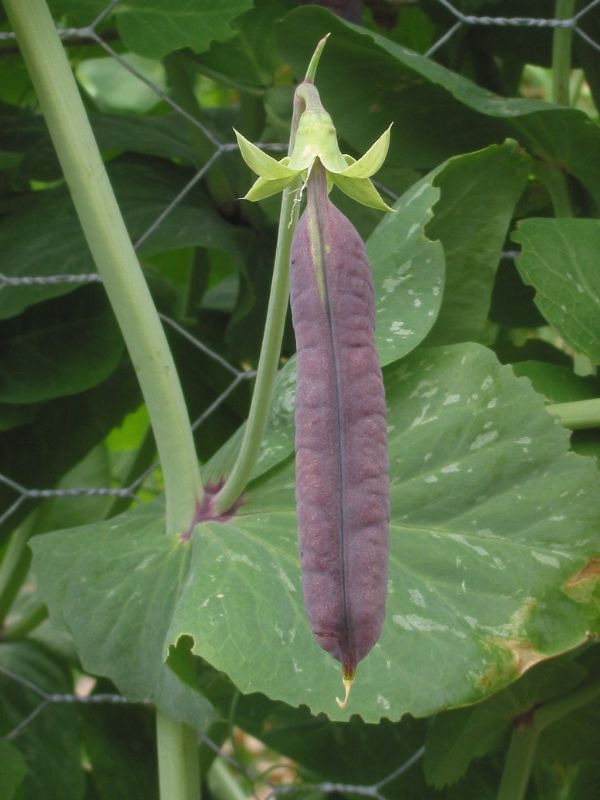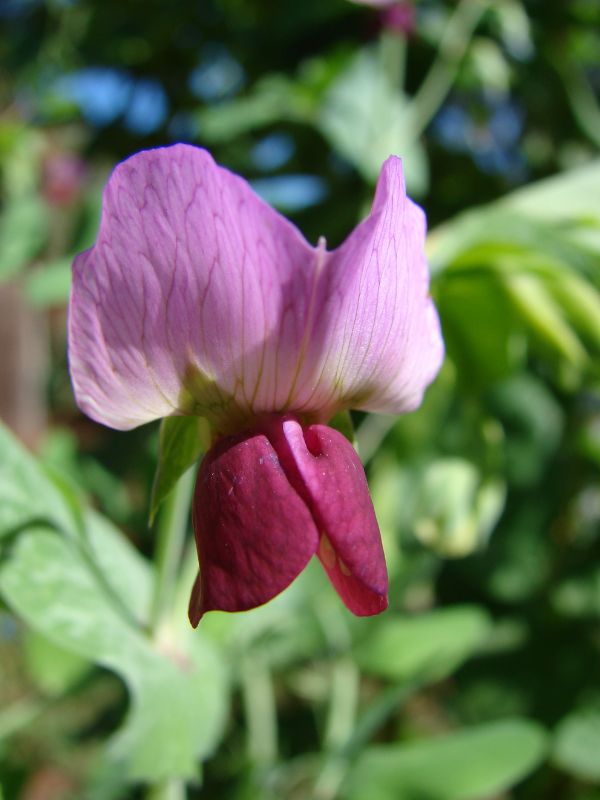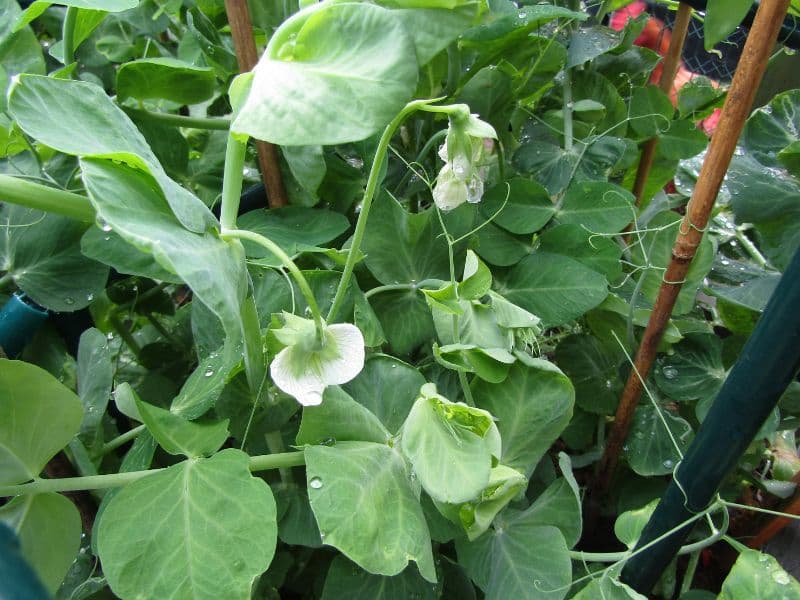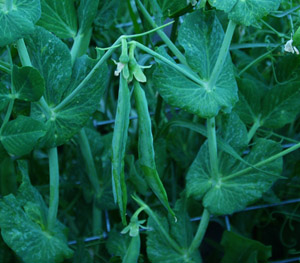Peas, also known as Austrian Winter Pea, English Pea, Field Pea, or Green Pea, belong to the Fabaceae family and are scientifically classified as Pisum sativum. Originating from Eurasia, this annual plant is a popular choice for home gardens due to its versatility and ease of cultivation.
Pea plants produce green or yellow pods, each containing several seeds, commonly called peas. While often associated with vegetables, peapods are technically classified as fruit because they develop from the ovary of a pea flower.
If you’re looking to add this nutrient-rich, fast-growing plant to your garden, understanding its care and growth requirements is key. Keep reading to explore how to grow and maintain pea plants for a successful harvest.
| Common name | Austrian Winter Pea, English Pea, Field Pea, Green Pea, Pea |
| Botanical name | Pisum sativum |
| Family | Fabaceae |
| Species | sativum |
| Origin | Eurasia |
| Life cycle | Annual |
| Plant type | Annual |
| Hardiness zone | 2, 3, 4, 5, 6, 7, 8, 9, 10, 11 |
| Sunlight | Full Sun |
| Maintenance | Medium |
| Soil condition | Clay |
| Soil ph | Neutral |
| Drainage | Well-Drained |
| Growth rate | Fast |
| Spacing | Less than 12 in. |
| Harvest time | Fall |
| Flowering period | Fall |
| Height | 1 ft. – 1 ft. 6 in. |
| Flower color | Pink |
| Leaf color | Green |
| Fruit color | Green |
| Stem color | Green |
| Fruit type | Legume |
| Fruit benefit | Edible |
| Flower benefit | Edible |
| Garden style | Children’s Garden |
| Uses | Container |
I. Appearance and Characteristics
Pea (Pisum in Latin) is a pulse, vegetable or fodder crop, but the word often refers to the seed or sometimes the pod of this flowering plant species, formerly ‘Pisum sativum’ (meaning cultivated pea), it has been proposed to rename the species as Lathyrus oleraceus. Each pod contains several seeds (peas), which can have green or yellow cotyledons when mature.
Botanically, pea pods are fruit, since they contain seeds and develop from the ovary of a (pea) flower. The name is also used to describe other edible seeds from the Fabaceae such as the pigeon pea (Cajanus cajan), the cowpea (Vigna unguiculata), the seeds from several species of Lathyrus and is used as a compound form for example Sturt’s desert pea.

The term pea originates from the Latin word pisum, which is the latinisation of the Greek πίσον (pison), neuter variant form of πίσος (pisos) ‘pea’. It was adopted into English as the noun pease (plural peasen), as in pease pudding. However, by analogy with other plurals ending in -s, speakers began construing pease as a plural and constructing the singular form by dropping the -s, giving the term pea. This process is known as back-formation.
A pea is a most commonly green, occasionally golden yellow, or infrequently purple pod-shaped vegetable, widely grown as a cool-season vegetable crop. The seeds may be planted as soon as the soil temperature reaches 10 °C (50 °F), with the plants growing best at temperatures of 13 to 18 °C (55 to 64 °F).
They do not thrive in the summer heat of warmer temperate and lowland tropical climates, but do grow well in cooler, high-altitude, tropical areas. Many cultivars reach maturity about 60 days after planting.
Peas have both low-growing and vining cultivars. The vining cultivars grow thin tendrils from leaves that coil around any available support and can climb to be 1 to 2 metres (3 ft 3 in to 6 ft 7 in) high. A traditional approach to supporting climbing peas is to thrust branches pruned from trees or other woody plants upright into the soil, providing a lattice for the peas to climb.
Branches used in this fashion are called pea sticks or sometimes pea brush. Metal fences, twine, or netting supported by a frame are used for the same purpose. In dense plantings, peas give each other some measure of mutual support. Pea plants can self-pollinate.
II. How to Grow and Care
Sunlight
Peas prefer full sun, meaning at least six hours of direct sunlight on most days. They can tolerate a bit of shade, though this can hinder production and affect taste.

Temperature and Humidity
Peas do best in mild temperatures between around 60 and 70 degrees Fahrenheit, though they do have good cold tolerance. Once the temperature is warmer than 85 degrees Fahrenheit, the plants will struggle. Humidity typically isn’t an issue as long as soil moisture needs are met.
Watering
Originating from regions with moderate climates, garden pea has adapted to a consistent moisture level, indicative of its preference for stable hydration. This species thrives when the soil remains evenly moist without becoming waterlogged, showcasing a balance in its water requirements. Watering should align with this equilibrium, translating to twice a week to maintain optimal health. Cultivated primarily outdoors, garden pea benefits from a well-draining soil that complements its growth cycles and ensures efficient use of water during irrigation.
Soil
Peas can grow in a variety of soil types as long as there is good drainage. For best results, plant your peas in a loamy soil that’s rich in organic matter. A slightly acidic to neutral soil pH is ideal.
Fertilizing

To bolster garden pea’s growth, apply high phosphorus and potassium fertilizers every 2-3 weeks during the active growing season. These nutrients enhance fruiting and root development, contributing to a robust harvest. Use a balanced, granular fertilizer according to package instructions, avoiding over-fertilization which can harm garden pea. As garden pea matures, taper off feeding to prevent excessive foliage. Always water garden pea thoroughly post-fertilization for nutrient uptake and to avert root burn. Maintain even fertilization throughout varying growth stages to ensure a healthy and productive garden pea.
Pruning
Pruning generally isn’t necessary for pea plants. But you can trim off small tendrils or shoots for eating. They have a mild, pea-like flavor that goes well in salads and other dishes.
Propagation
Pea plants can be propagated by saving their seeds. Not only is this an inexpensive way to produce new plants, but it also will allow you to propagate particular varieties that you enjoyed. Here’s how:
- Allow healthy pods to remain on the plant to dry.
- Once they’ve browned and you can hear the seeds rattle inside, twist the pods off the plant.
- Remove the seeds from the pods, and spread them out on a screen indoors to fully dry for a few days. Make sure you’ve only kept the seeds, not any excess plant material.
- Store the dried seeds in an envelope marked with the date. They should be viable for a few years.
How to Grow From Seed
Prior to planting, soak the seeds in warm water overnight. This will help to speed up their germination. Then, plant them in loosened soil. And make sure the soil is lightly moist but not wet, as this can rot the seeds. Expect germination in about a week if the soil is 65 degrees Fahrenheit or above. The seeds can take up to a month to germinate in soil that’s around 40 degrees Fahrenheit.
Overwintering
Pea plants are annuals, meaning they complete their life cycle in one growing season. So overwintering them won’t be necessary.
How to Grow in Pots
If you don’t have the garden space or the right soil conditions to grow peas, you can try a container. Use a pot with drainage holes that’s at least 12 inches wide and deep. An unglazed clay container is ideal because it will allow excess soil moisture to evaporate through its walls.

Aim to plant in a container that will fit the mature plant’s size, as peas don’t do well when transplanted. Use a fast-draining organic potting soil made for vegetables. Also, if you’re growing a vining variety, you’ll need to add a support structure to the container.
Pests and Diseases
Aphids, pea weevils, and other insects can infest pea plants, attacking both the leaves and the roots. Try organic, food-safe measures, such as knocking off the insects with a strong spray of water or using an insecticidal soap, to mitigate pest problems. You also can grow companion plants that deter insects. For example, aphids can be repelled by rosemary plants.
Fungal diseases, including fusarium wilt and powdery mildew, also can impact pea plants. It’s typically best to destroy the affected plants to prevent diseases from spreading.
III. Uses and Benefits
- Culinary uses
In modern times peas are usually boiled or steamed, which breaks down the cell walls and makes them taste sweeter and the nutrients more bioavailable. Along with broad beans and lentils, these formed an important part of the diet of most people in the Middle East, North Africa and Europe during the Middle Ages. By the 17th and 18th centuries, it had become popular to eat peas “green”, that is, while they are immature and right after they are picked.
New cultivars of peas were developed by the English during this time, which became known as “garden” or “English” peas. The popularity of green peas spread to North America. Thomas Jefferson grew more than 30 cultivars of peas on his estate. With the invention of canning and freezing of foods, green peas became available year-round, and not just in the spring as before.
Fresh peas are often eaten boiled and flavored with butter and/or spearmint as a side dish vegetable. Salt and pepper are also commonly added to peas when served. Fresh peas are also used in pot pies, salads and casseroles. Pod peas (snow peas and snap peas) are used in stir-fried dishes, particularly those in American Chinese cuisine. Pea pods do not keep well once picked, and if not used quickly, are best preserved by drying, canning or freezing within a few hours of harvest.

In India, fresh peas are used in various dishes such as aloo matar (curried potatoes with peas) or mattar paneer (paneer cheese with peas), though they can be substituted with frozen peas as well. Peas are also eaten raw, as they are sweet when fresh off the bush. Green Peas known as Hasiru Batani in Kannada are used to make curry and Gasi. Split peas are also used to make dal, particularly in Guyana, and Trinidad, where there is a significant population of Indians.
Dried peas are often made into a soup or simply eaten on their own. In Japan, China, Taiwan and some Southeast Asian countries, including Thailand, the Philippines and Malaysia, peas are roasted and salted, and eaten as snacks. In the Philippines, peas, while still in their pods, are a common ingredient in viands and pansit. In the UK, dried yellow or green split peas are used to make pease pudding (or “pease porridge”), a traditional dish. In North America, a similarly traditional dish is split pea soup.
Pea soup is eaten in many other parts of the world, including northern Europe, parts of middle Europe, Russia, Iran, Iraq and India.
In Chinese cuisine, the tender new growth [leaves and stem] dou miao (豆苗; dòu miáo) are commonly used in stir-fries. Much like picking the leaves for tea, the farmers pick the tips off of the pea plant.
In Greece, Tunisia, Turkey, Cyprus, and other parts of the Mediterranean, peas are made into a stew with lamb and potatoes.
In Hungary and Serbia, pea soup is often served with dumplings and spiced with hot paprika.
In the United Kingdom, dried, rehydrated and mashed marrowfat peas, or cooked green split peas, known as mushy peas, are popular, originally in the north of England, but now ubiquitously, and especially as an accompaniment to fish and chips or meat pies, particularly in fish and chip shops. Sodium bicarbonate is sometimes added to soften the peas. In 2005, a poll of 2,000 people revealed the pea to be Britain’s seventh favourite culinary vegetable.
Processed peas are mature peas which have been dried, soaked and then heat treated (processed) to prevent spoilage—in the same manner as pasteurizing. Cooked peas are sometimes sold dried and coated with wasabi, salt, or other spices.
In North America pea milk is produced and sold as an alternative to cow milk for a variety of reasons.
- Pea sprouts
In East Asia, pea sprouts or shoots (豆苗; 완두순) were once dedicated cuisine when the plant was less highly available. Today, when the plant can be easily grown, fresh pea shoots are available in supermarkets or may be grown at home.
IV. Harvesting and Storage

Kolforn (Kolforn)
CC BY-SA 4.0
Harvesting
Once your pea plant is in bloom, check regularly for harvestable peas. In general, most varieties take an average of 65 days after planting to be ready to harvest. Snow peas are ready when their pods show small peas inside. Snap peas are ready when the pods are plump and glossy. And garden peas are ready when the pods are fully formed but not yet dull or waxy.
The best time to pick peas is in the morning, as they will have the most plumpness then. Gently twist the pods off the vines with your hands, being careful not to damage the vine and pods that are still developing.
Peas are best used as soon as possible after harvesting.
Frozen
In order to freeze and preserve peas, they must first be grown, picked, and shelled. Usually, the more tender the peas are, the more likely that they will be used in the final product. The peas must be put through the process of freezing shortly after being picked so that they do not spoil too soon. Once the peas have been selected, they are placed in ice water and allowed to cool. After, they are sprayed with water to remove any residual dirt or dust that may remain on them.
The next step is blanching. The peas are boiled for a few minutes to remove any enzymes that may shorten their shelf life. They are then cooled and removed from the water. The final step is the actual freezing to produce the final product. This step may vary considerably; some companies freeze their peas by air blast freezing, where the vegetables are put through a tunnel at high speeds and frozen by cold air. Finally, the peas are packaged and shipped out for retail sale.
Find Where to Buy the Best Pea (Pisum sativum)





![Pea (Pisum sativum) 12 Pisum sativum ‘Sugar Magnolia’ (Garden Pea) [12 Seeds]](https://i0.wp.com/hayefield.com/wp-content/uploads/2021/11/Pisum-sativum-Sugar-Magnolia-Ondra-1.jpg?fit=500%2C500&ssl=1)








Leave a Reply